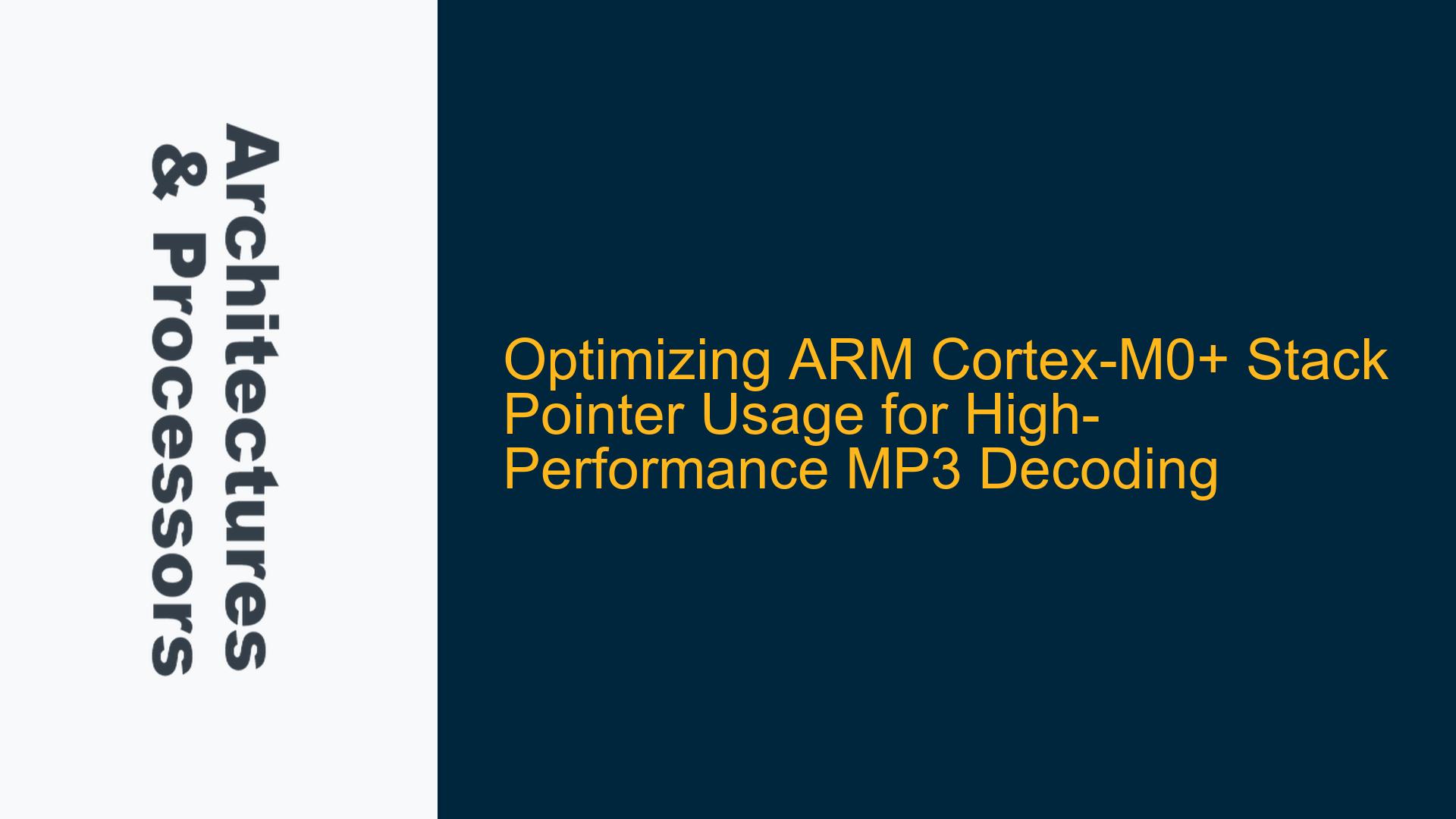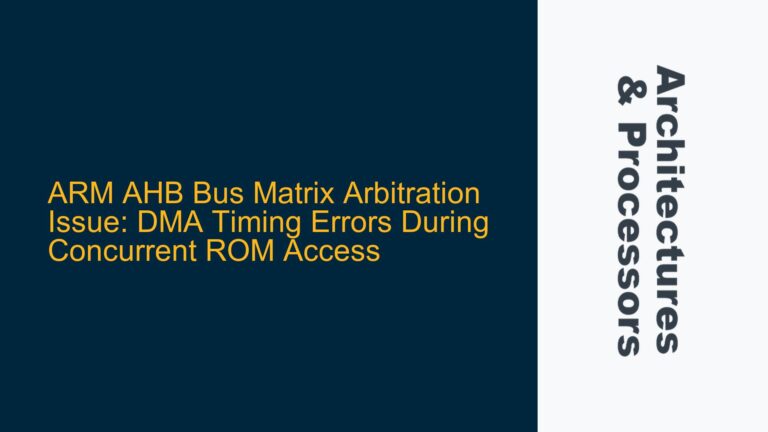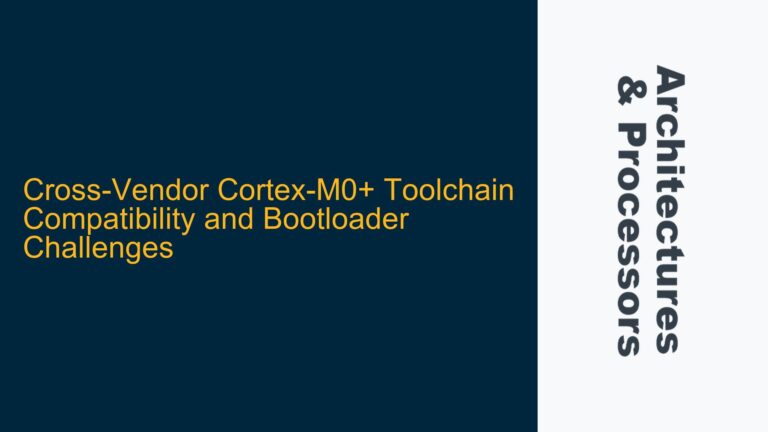Cortex-M0+ Stack Pointer (PSP/MSP) Usage Constraints in High-Performance Applications
The ARM Cortex-M0+ processor, while being a highly efficient and low-power microcontroller, presents unique challenges when optimizing performance-critical applications such as MP3 decoding. One of the key issues arises from the dual-stack pointer architecture, which includes the Main Stack Pointer (MSP) and the Process Stack Pointer (PSP). The MSP is typically used for exception handling and interrupt service routines (ISRs), while the PSP is intended for thread or task execution. However, in performance-critical applications, developers often attempt to leverage the stack pointer (SP) for general-purpose data storage or addressing, which can lead to unintended behavior due to the Cortex-M0+’s architectural constraints.
The Cortex-M0+ automatically uses the current stack pointer (either MSP or PSP) for stacking registers during exception entry. This means that if the SP is repurposed for data storage or addressing, the processor will overwrite the stored data during an interrupt or exception, leading to data corruption or system crashes. This behavior is particularly problematic in applications like MP3 decoding, where cycle efficiency and memory access optimization are critical. The Cortex-M0+ lacks the flexibility of more advanced cores like the Cortex-M4, which allows for greater control over stack usage and memory access patterns.
Misuse of Stack Pointer for Data Addressing and Self-Modifying Code
A common optimization technique in assembly programming is to use the stack pointer as a general-purpose address register, especially when dealing with large datasets or frequent memory accesses. In the context of MP3 decoding, this approach can seem attractive due to the Thumb instruction set’s efficient immediate offset addressing modes. For example, instructions like LDR R0, [R13, #1024] allow for quick access to data stored at fixed offsets from the stack pointer. However, this technique is fraught with risks on the Cortex-M0+.
The Cortex-M0+ architecture limits the maximum immediate offset for load/store instructions to 1020 bytes, and the offset must be a multiple of 4. This restriction can complicate memory access patterns, especially when dealing with large buffers or datasets. Additionally, the use of self-modifying code (SMC) to dynamically adjust offsets or instructions can further exacerbate the problem. While SMC can reduce the number of memory accesses and improve cycle efficiency, it introduces significant complexity and debugging challenges. Moreover, SMC requires the code to reside in RAM, which increases the memory footprint and limits the scalability of the application.
Another critical issue is the potential for stack corruption during interrupts. If the stack pointer is used as a data pointer, any interrupt or exception will cause the processor to push registers onto the stack, overwriting the data stored at the SP location. This behavior is particularly problematic in real-time applications like MP3 decoding, where interrupts are frequent and timing is critical. Disabling interrupts during critical sections of code is a potential workaround, but this approach introduces additional overhead and can negatively impact system responsiveness.
Implementing Safe and Efficient Stack Usage for MP3 Decoding on Cortex-M0+
To address the challenges of stack pointer usage on the Cortex-M0+, developers must adopt a disciplined approach to memory management and code optimization. The following strategies can help ensure safe and efficient stack usage while maximizing performance:
1. Separate Stack and Data Memory Regions
The most effective way to avoid stack corruption is to maintain a clear separation between the stack and data memory regions. Instead of using the stack pointer for data addressing, allocate a dedicated buffer in RAM for the dataset. This approach ensures that the stack pointer is only used for its intended purpose, while the data buffer can be accessed using general-purpose registers or fixed memory addresses.
For example, instead of using LDR R0, [R13, #1024] to access data, allocate a buffer in RAM and use LDR R0, [R5, #0], where R5 points to the base address of the buffer. This approach eliminates the risk of stack corruption during interrupts and allows for more flexible memory access patterns.
2. Use Link Register (LR) for Temporary Storage
The Cortex-M0+ architecture allows the Link Register (LR) to be used as a temporary storage location, which can help reduce the reliance on the stack pointer. By storing intermediate values in the LR, developers can minimize the number of memory accesses and improve cycle efficiency. However, care must be taken to preserve the LR’s value before using it for temporary storage, as it is also used for function return addresses.
For example, before using the LR for temporary storage, save its value to the stack or another register:
PUSH {LR} ; Save the Link Register
MOV LR, R0 ; Use LR for temporary storage
; Perform operations using LR
POP {LR} ; Restore the Link Register
3. Optimize Memory Access Patterns
The Thumb instruction set provides several efficient memory access instructions, such as LDM (Load Multiple) and STM (Store Multiple), which can be used to optimize memory access patterns. By loading or storing multiple registers in a single instruction, developers can reduce the number of memory accesses and improve performance.
For example, instead of loading each register individually:
LDR R0, [R5, #0]
LDR R1, [R5, #4]
LDR R2, [R5, #8]
Use the LDM instruction to load multiple registers in a single operation:
LDM R5, {R0-R2} ; Load R0, R1, and R2 from memory
4. Avoid Self-Modifying Code
While self-modifying code can provide performance benefits in some cases, it is generally not recommended for the Cortex-M0+ due to the increased complexity and debugging challenges. Instead, focus on optimizing the code structure and memory access patterns to achieve the desired performance. Unrolling loops and using inline functions can help reduce the number of memory accesses and improve cycle efficiency without resorting to SMC.
5. Leverage Hardware Features and Peripherals
The Cortex-M0+ includes several hardware features and peripherals that can be used to offload processing tasks and improve performance. For example, the Direct Memory Access (DMA) controller can be used to transfer data between memory and peripherals without CPU intervention, freeing up cycles for other tasks. Additionally, the SysTick timer can be used to implement precise timing for real-time applications like MP3 decoding.
6. Profile and Optimize Critical Code Sections
Profiling the application to identify performance bottlenecks is essential for optimizing critical code sections. Tools like ARM’s Keil MDK or IAR Embedded Workbench provide profiling capabilities that can help identify the most time-consuming functions or instructions. Once the bottlenecks are identified, focus on optimizing these sections using the techniques described above.
7. Consider Advanced Architectures for Complex Applications
While the Cortex-M0+ is a highly efficient microcontroller, it may not be suitable for all applications, especially those with high computational requirements like MP3 decoding. In such cases, consider using more advanced architectures like the Cortex-M4 or Cortex-M7, which provide additional features like hardware floating-point units (FPUs) and DSP extensions. These features can significantly improve performance for computationally intensive tasks.
By following these strategies, developers can safely and efficiently use the Cortex-M0+ stack pointer while maximizing performance for demanding applications like MP3 decoding. The key is to maintain a clear separation between stack and data memory, optimize memory access patterns, and leverage the Cortex-M0+’s hardware features to achieve the desired performance without compromising system stability.






